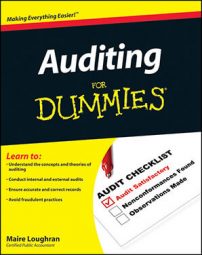You can choose your audit sample without using any type of specific statistical sampling method. The basic premise of statistical and nonstatistical sampling is the same. However, when performing an audit, be aware of these differences that do exist. They impact how you determine the sample size and select the items to sample.
Determining the sample size
When using nonstatistical sampling, you don’t use tables or statistical percentages. The number of records you look at is based on your professional judgment and firm policy. Further, for consistency throughout the CPA firm and to reduce the amount of judgment auditors need to apply in the field, many public CPA firms have universal guidelines for the auditors to follow when selecting a sample size. In other words, when X happens, it’s firm policy to select Y records.
For example, if the client’s control risk (or inherent risk, or detection risk — the X) is high, firm policy may dictate that the sample size must be 100 to 150 records (the associated Y). Moderate risk may set the sample size to 50 to 75 records, and a low-risk records sample may be 20 to 45. Keep in mind that I’m just making up these numbers to illustrate the point.
Control risk is the risk that a material misstatement could occur that’s not detected in a timely fashion by internal controls. Inherent risk occurs when accounts are susceptible to material misstatements, and detection risk is the risk that an auditor won’t detect a material misstatement.
A firm’s sample size guidelines aren’t set up willy-nilly. Firm experts carefully consider many different factors such as control confidence level and reasonable tolerable deviation rates. Of course, if you find one or more deviations, you should expand the sample size or reassess the level of control risk.
Selecting items to sample
Two of the sampling methods put into play when nonstatistical sampling is used are haphazard and judgment sampling.
Haphazard sampling takes place when you choose a sample of the records in a population without any conscious bias. However, you should try to select records that are representative of the entire population of records. For example, you wouldn’t throw all vendor invoices into the air and base your sample on whether the invoice lands face up or face down (although that does sound very haphazard, doesn’t it?).
When you use your professional judgment to select the sample, it’s called — big surprise — judgment sampling. Auditors use many different facts and circumstances when applying professional judgment to sampling, among them their previous audit experiences with the client or the client’s industry.
Whatever sampling method you decide to use, you have to avoid distorting the sample by selecting only large items or items that are shown first or last in a list of records. Sampling is only effective when the sample comes as close as possible to representing the population of records as a whole.

